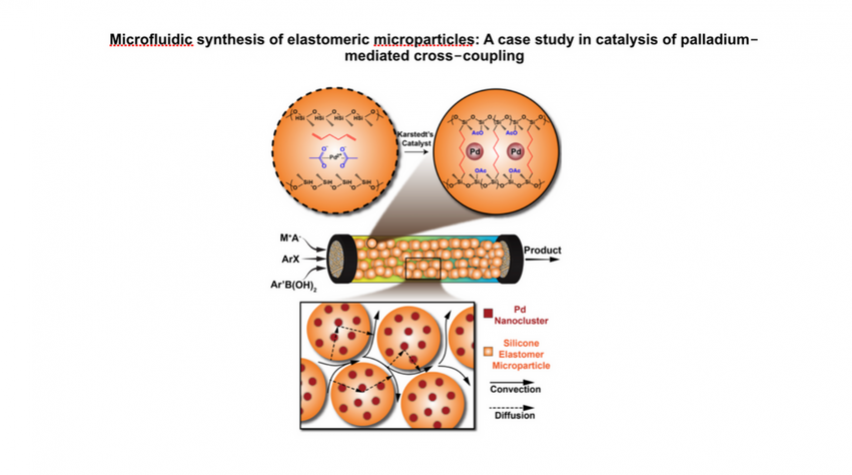
Schematic of Pd-loaded PHMS microparticle synthesis by hydrosilylation cross-coupling and construction of the μ-PBR.
About 70 percent of pharmaceuticals are manufactured using palladium-driven catalytic processes that are either fast or efficient – but not both.
An AIChE Journal article, “Microfluidic Synthesis of Elastomeric Microparticles: A Case Study in Catalysis of Palladium-Mediated Cross-Coupling” by Jeffrey A. Bennett, Andrew J. Kristof, Vishal Vasudevan, Jan Genzer, Jiri Srogl, and Milad Abolhasani (corresponding author) of the Dept. of Chemical and Biomolecular Engineering, North Carolina State University, Raleigh, NC, discusses the development of a green chemistry method that combines aspects of both processes to improve efficiency at a minimal cost of processing time. (Full article can be read for free for a limited time here.)
Specifically, these palladium-driven catalytic reactions are used to connect carbons in small, organic molecules to create larger molecules for use in pharmaceuticals and other applications. Traditionally, there have been two ways to do this.
In homogeneous processes, palladium is dissolved in solution, allowing maximum exposure to the organic molecules, or reagents. This makes the process very fast, but results in a lot of palladium either being wasted (because it gets thrown out after target molecules are harvested) or being recovered at high cost (because the recovery process is expensive).
In heterogeneous processes, palladium is fixed to a hard substrate in a pack-bed reactor, and the reagents are run through the reactor. This takes much longer, but little or no palladium is wasted.
“We’ve created and tested a new process called pseudo-homogeneous catalysis, which combines the best of both worlds: it is nearly as fast as homogeneous catalysis, while it preserves virtually all of the palladium,” says Milad Abolhasani, an assistant professor of chemical engineering at NC State and corresponding author of a paper on the work.” [Source]
Exceptional Altmetric Attention Score
The article, to be published this year in the AIChE Journal Futures Issue (a new annual feature intended to engage early-career researchers with ≤ 7 yrs of experience beyond PhD/postdoc; the goal is to make AIChE Journal better aligned with the U.S. research) has a very high Altmetric Attention Score of 56.
This Attention Score is in the top 5% of all research outputs scored by Altmetric. This is one of the highest-scoring outputs from this source (#1 of 374). It is 88th percentile compared to outputs of the same age. It is 80th percentile compared to outputs of the same age and source. More information appears here.
Altmetrics are metrics and qualitative data that are complementary to traditional, citation-based metrics such as journal impact factor. Sourced from the Web, Altmetrics provide much information about how often journal articles and other scholarly outputs like datasets are discussed and used around the world. Altmetrics track the use and discussion of research from online discussions and forums: social media, research blogs, public policy documents, news articles and more.
Each article published in AIChE journals (AIChE Journal, BioTM, BTPR, EP&SE, and PSP) on the Wiley Online Library includes an Altmetric score icon linked to an overview of attention for article published in the journal. Information is provided as to who is discussing the article, where those readers are located, and what their professions are.
AIChE Journal
The AIChE Journal is the premier research monthly in chemical engineering and related fields. This peer-reviewed and broad-based journal reports on the most important and latest technological advances in core areas of chemical engineering as well as in other relevant engineering disciplines. Learn more here.


